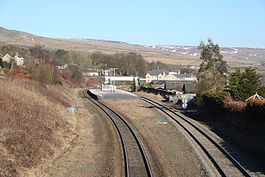Chinley railway station
| Chinley |
|
|---|---|

Chinley Railway Station
|
|
| Location | |
| Place | Chinley |
| Local authority | High Peak |
| Grid reference | SK038826 |
| Operations | |
| Station code | CLY |
| Managed by | Northern |
| Number of platforms | 2 |
| DfT category | F2 |
| Live arrivals/departures, station information and onward connections from National Rail Enquiries |
|
| Annual rail passenger usage* | |
| 2011/12 |
|
| – Interchange |
|
| 2012/13 |
|
| – Interchange |
|
| 2013/14 |
|
| – Interchange |
|
| 2014/15 |
|
| – Interchange |
|
| 2015/16 |
|
| – Interchange |
|
| History | |
| Key dates | Opened 1867 |
| 1 July 1902 | Moved to current location |
| National Rail – UK railway stations | |
| * Annual estimated passenger usage based on sales of tickets in stated financial year(s) which end or originate at Chinley from Office of Rail and Road statistics. Methodology may vary year on year. | |
|
|
|
Chinley railway station serves the village of Chinley in Derbyshire, England. The station is 17 1⁄2 miles (28.2 km) south east of Manchester Piccadilly, on the Hope Valley Line from Sheffield to Manchester. It is unstaffed, and is managed by Northern.
The original station was built in 1867 by the Midland Railway on the extension of its Manchester, Buxton, Matlock and Midlands Junction Railway which became its main line to London from Manchester. Originally, the Midland had planned to extend through Buxton, but the LNWR already had a line there, so the Midland built a line through Chinley and Buxworth to join the Manchester, Sheffield and Lincolnshire Railway at New Mills, in an association which became known as the Sheffield and Midland Railway Companies' Committee.
From Millers Dale the line crossed the Black Brook valley at Chapel Milton. This became a double viaduct when the Dore and Chinley line was built in 1894, with a north curve forming a triangular junction just over a mile to the east.
...
Wikipedia
